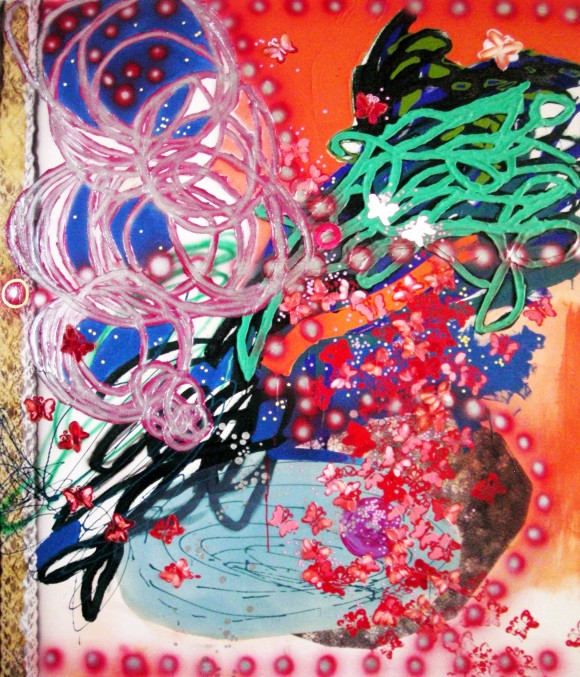Welcome to the wild and wacky world of modern art, where a banana duct-taped to a wall can be worth more than your car and a urinal can pass as a masterpiece. In this article, we will delve into the mind-boggling intricacies of modern art, where anything goes and nothing is off-limits. So grab your beret and let’s journey into a realm where creativity knows no bounds and the only rule is that there are no rules.
Overview of Modern Art Movements
Ready to dive headfirst into the world of modern art movements? Strap in! We’re about to take a whirlwind tour through some of the most influential and eccentric movements that have shaped the art world as we know it.
First up, we have Cubism. Picture this: artists deciding that perfectly capturing reality on canvas was just too mainstream. Instead, they rebelled against tradition by breaking down objects into geometric shapes and rearranging them to create a fragmented, abstract masterpiece.
Next, let’s talk about Surrealism. Ever dreamt of seeing a melting clock or flying fish in a painting? Well, Surrealist artists like Salvador Dali and René Magritte made those dreams a reality. Buckle up for a wild ride through the subconscious mind with this mind-bending movement.
And who could forget Pop Art? If you’ve ever seen a Campbell’s Soup can or a brightly colored Marilyn Monroe portrait, you’ve witnessed the playful and vibrant world of Pop Art. With artists like Andy Warhol and Roy Lichtenstein leading the charge, this movement celebrates all things popular and kitsch.
Evolution of Abstract Expressionism
Abstract Expressionism started as a bunch of artists splattering paint on canvas and calling it innovative. But oh, how it evolved over time!
From the early days of Jackson Pollock flinging paint with the grace of a toddler on a sugar high, to Mark Rothko creating those big blocks of color that made everyone question if they needed glasses, Abstract Expressionism was a wild ride.
As the movement progressed, artists started exploring deeper emotional depths, creating works that made viewers ponder the meaning of life, the universe, and whether that red blob in the corner was intentional or just a happy accident.
- Color Became King: Artists like Willem de Kooning and Helen Frankenthaler pushed the boundaries of color theory, proving that you can make a statement with just a few well-placed hues.
- Gestural Abstraction: The physical act of painting became a performance art in itself, with artists like Franz Kline and Joan Mitchell using bold, sweeping gestures to convey raw emotion on canvas.

Influence of Postmodernism on Contemporary Art
Postmodernism has had a significant impact on contemporary art, shaping the way artists approach their work and challenging traditional artistic norms. Here are a few ways in which postmodernism has influenced the art world:
- Deconstruction: Postmodernism encourages artists to break down established ideas and question the meaning behind them. This has led to a rise in artwork that challenges the viewer to reconsider their perceptions and assumptions.
- Multiculturalism: Postmodernism celebrates diversity and encourages artists to draw inspiration from various cultures and traditions. This has resulted in a melting pot of artistic styles and influences, creating a rich tapestry of creative expression.
- Technological innovation: Postmodernism embraces new technologies and encourages artists to experiment with different mediums and techniques. This has led to the rise of digital art, interactive installations, and other cutting-edge forms of artistic expression.
Overall, postmodernism has pushed the boundaries of contemporary art, challenging artists and audiences alike to think outside the box and explore new ways of creating and experiencing art. It has sparked a creative revolution that shows no signs of slowing down, reshaping the art world in exciting and unexpected ways.

Exploring Minimalism and Conceptual Art
Let’s dive into the world of minimalism and conceptual art, where less is definitely more! Forget about cluttered paintings and over-the-top sculptures, we’re here to appreciate the beauty of simplicity and the power of ideas.
Imagine a canvas with just one bold brushstroke, or a sculpture made from a single piece of metal - that’s the essence of minimalism. It’s all about distilling art down to its purest form, letting the viewer’s imagination fill in the blanks. Who needs fancy details when you can convey a powerful message with just a few elements?
On the other hand, conceptual art takes things a step further by emphasizing the idea behind the artwork rather than its physical form. It’s like the art world’s version of a mind puzzle - you might not “get it” at first glance, but once you unravel the concept behind the piece, it’s like a light bulb moment!
So, next time you’re at a gallery or museum, keep an eye out for those sleek, thought-provoking pieces that challenge your perception of art. Who knows, you might just discover a whole new appreciation for the beauty of simplicity and the power of ideas!

Intersection of Technology and Art
Technology and art have finally collided in a beautiful explosion of creativity and innovation. No longer are they two separate entities, but now they dance together in a harmonious union that is taking the world by storm.
Imagine a world where paintings come to life with augmented reality, sculptures are created with 3D printing, and music is composed by artificial intelligence. The possibilities are endless when these two worlds collide.
With the rise of digital art galleries and virtual reality experiences, artists are finding new ways to express themselves and connect with audiences around the globe. It’s like Bob Ross meets Elon Musk, a match made in creative heaven.
In this brave new world, creativity knows no bounds. Artists are using technology to push the boundaries of what is possible, creating masterpieces that wow and inspire. The is a place where imagination reigns supreme and the only limit is the artist’s own creativity.
Challenging Traditional Boundaries in Artistic Expression
Who says art has to fit into a neat little box? Not us, that’s for sure! We’re all about pushing the boundaries and breaking free from the constraints of traditional artistic expression. Why be conventional when you can be extraordinary?
One of the ways we love to challenge the norm is by experimenting with unexpected materials. Forget canvas and paint – we’re talking about using bubble wrap, spaghetti, and even old socks to create masterpieces that defy all expectations. Who knew that an old shoe could be transformed into a sculpture that leaves viewers scratching their heads in amazement?
We also believe in blurring the lines between different art forms. Why stick to just painting or sculpture when you can combine the two to create something truly unique? Picture a painting that jumps off the canvas and becomes a 3D masterpiece that you can walk around and explore from all angles. Now that’s what we call thinking outside the box!
And let’s not forget about the importance of challenging societal norms in our art. We believe in using our work to spark conversations, provoke thought, and inspire change. Whether it’s a controversial political statement or a whimsical piece that challenges gender stereotypes, we’re not afraid to tackle the tough topics and push our audience to think differently. After all, art should never be safe – it should be bold, daring, and unapologetically original.
Impact of Globalization on Modern Art Trends
Globalization has had a profound impact on modern art trends, influencing artists to think outside the box and push boundaries like never before. Here are some ways in which globalization has shaped the art world:
- Diversity: Globalization has opened up opportunities for artists to explore different cultures and perspectives, leading to a rich and diverse range of artistic styles and themes.
- Collaboration: With the ease of communication and travel, artists from different parts of the world can now collaborate on projects, resulting in unique and innovative works of art.
- Technology: Globalization has also brought about advancements in technology, allowing artists to experiment with new mediums and techniques, from digital art to virtual reality.
However, it’s not all smooth sailing in the world of globalized art trends. Some critics argue that globalization has led to a homogenization of artistic expression, with certain styles becoming popular worldwide at the expense of local and traditional art forms.
Despite the challenges, one thing is clear: globalization has forever changed the landscape of modern art, challenging artists to think globally while still staying true to their unique voices and visions.
FAQs
What makes modern art so confusing to understand?
Well, imagine trying to solve a Rubik’s cube blindfolded while riding a unicycle on a tightrope – that’s basically modern art in a nutshell. It’s all about pushing boundaries, challenging norms, and sometimes leaving you scratching your head in confusion.
How can someone appreciate modern art if they don’t understand it?
Think of modern art like a language that you don’t speak fluently – you may not understand every word, but you can still appreciate the beauty of the sounds and rhythms. Just trust your gut instincts, embrace the ambiguity, and don’t be afraid to ask questions (even if they sound silly).
Why do some people dismiss modern art as just a bunch of random splatters or shapes?
Well, let’s be real – it’s easy to look at a canvas covered in random splatters and think, “My cat could do that.” But what sets modern art apart is the intention behind the chaos. Each splatter, shape, or blob is carefully curated to evoke emotions, stir thoughts, and challenge perceptions. So, next time you see a “random” artwork, take a closer look – you might just uncover a hidden masterpiece.
Is it okay to not “get” modern art?
Absolutely! Remember, art is subjective – what speaks to one person may leave another scratching their head. It’s okay to feel lost, confused, or even frustrated by modern art. Just remember, the journey of exploring art is half the fun – embrace the confusion, ask questions, and don’t be afraid to dive into the unknown. Who knows, you might just discover a new perspective along the way.
—
In conclusion, dive into the wonderful world of modern art with an open mind and a sense of humor!
Whether you find yourself pondering the deep meaning behind a simple line on a canvas or laughing at a sculpture that looks like it belongs in a preschool, remember that art is meant to be interpreted in a myriad of ways. So next time you come across a piece that leaves you scratching your head, just embrace the confusion and enjoy the ride! After all, as they say, beauty is in the eye of the bewildered beholder.






